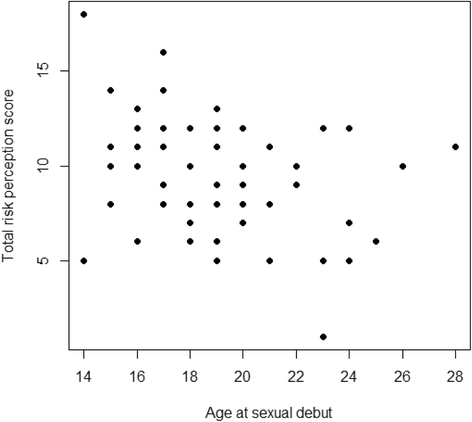Knowledge and risk perception of oral cavity and oropharyngeal cancer among non-medical university students
- PMID: 26818939
- PMCID: PMC4730637
- DOI: 10.1186/s40463-016-0120-z
Knowledge and risk perception of oral cavity and oropharyngeal cancer among non-medical university students
Abstract
Background: To assess non-medical university students' knowledge and perceived risk of developing oral cavity and oropharyngeal cancer.
Methods: A cross-sectional survey was conducted among non-medical students of a private Midwestern university in the United States in May 2012. Questionnaire assessed demographic information and contained 21 previously validated questions regarding knowledge and perceived risk of developing oral cavity and oropharyngeal cancer. Knowledge scale was categorized into low and high. Risk level was estimated based on smoking, drinking, and sexual habits. Bivariate associations between continuous and categorical variables were assessed using Pearson correlation and Chi-square tests, respectively.
Results: The response rate was 87% (100 out of 115 students approached). Eighty-one percent (81%) had low oral cavity and oropharyngeal cancer knowledge; and only 2% perceived that their oral cavity and oropharyngeal cancer risk was high. Risk perception was negatively correlated with age at sexual debut, r (64) = -0.26, p = 0.037; one-way ANOVA showed a marginally significant association between risk perception and number of sexual partners, F(4, 60) = 2.48, p = 0.05. There was no significant association between knowledge and perception of risk; however, oral cavity and oropharyngeal cancer knowledge was significantly associated with frequency of prevention of STDs (p < 0.05). Although 86% had heard about oral cavity and oropharyngeal cancer, only 18% had heard of oral mouth examination, and 7% of these reported ever having an oral cavity and oropharyngeal cancer exam.
Conclusions: Oral cavity and oropharyngeal cancer knowledge and risk perception is low among this student population. Since oral cavity and oropharyngeal cancer incidence is increasingly shifting towards younger adults, interventions must be tailored to this group in order to improve prevention and control.
Figures


Similar articles
-
Awareness and Knowledge of Oral Cancer among Medical Students in Kathmandu University School of Medical Sciences.Kathmandu Univ Med J (KUMJ). 2017 Jan.-Mar.;15(57):75-77. Kathmandu Univ Med J (KUMJ). 2017. PMID: 29446368
-
Exploring lay public and dental professional knowledge around HPV transmission via oral sex and oral cancer development.BMC Public Health. 2019 Nov 15;19(1):1529. doi: 10.1186/s12889-019-7923-6. BMC Public Health. 2019. PMID: 31729969 Free PMC article.
-
Assessing oral cancer knowledge and awareness among Malaysian dental and medical students.J Cancer Res Ther. 2014 Oct-Dec;10(4):903-7. doi: 10.4103/0973-1482.138011. J Cancer Res Ther. 2014. PMID: 25579526
-
Dental hygienists' knowledge, opinions, and practices related to oral and pharyngeal cancer risk assessment.J Dent Hyg. 2001 Fall;75(4):271-81. J Dent Hyg. 2001. PMID: 11813674 Review.
-
Oral Microbiome: A New Biomarker Reservoir for Oral and Oropharyngeal Cancers.Theranostics. 2017 Sep 26;7(17):4313-4321. doi: 10.7150/thno.21804. eCollection 2017. Theranostics. 2017. PMID: 29158828 Free PMC article. Review.
Cited by
-
Society of Behavioral Medicine position statement: Society of Behavioral Medicine supports oral cancer early detection by all healthcare providers.Transl Behav Med. 2019 Jul 16;9(4):819-822. doi: 10.1093/tbm/iby075. Transl Behav Med. 2019. PMID: 30007335 Free PMC article.
-
Epigenetics of oropharyngeal squamous cell carcinoma: opportunities for novel chemotherapeutic targets.J Otolaryngol Head Neck Surg. 2017 Jan 31;46(1):9. doi: 10.1186/s40463-017-0185-3. J Otolaryngol Head Neck Surg. 2017. PMID: 28143553 Free PMC article. Review.
-
Transoral robotic surgery with radial forearm free flap reconstruction: case control analysis.J Otolaryngol Head Neck Surg. 2017 Mar 14;46(1):20. doi: 10.1186/s40463-017-0196-0. J Otolaryngol Head Neck Surg. 2017. PMID: 28292318 Free PMC article.
-
Medical students' knowledge of HPV, HPV vaccine, and HPV-associated head and neck cancer.Hum Vaccin Immunother. 2022 Nov 30;18(6):2109892. doi: 10.1080/21645515.2022.2109892. Epub 2022 Sep 7. Hum Vaccin Immunother. 2022. PMID: 36070503 Free PMC article.
-
Risk perception of non-communicable diseases: A systematic review on its assessment and associated factors.PLoS One. 2023 Jun 1;18(6):e0286518. doi: 10.1371/journal.pone.0286518. eCollection 2023. PLoS One. 2023. PMID: 37262079 Free PMC article.
References
-
- American Cancer Society . Cancer Facts & Figures 2012. Atlanta: American Cancer Society; 2012.
-
- National Cancer Institute. Common cancer types. http://www.cancer.gov/cancertopics/types/commoncancers.
-
- National Cancer Institute, SEER cancer statistics review 1975–2008.http://seer.cancer.gov/archive/csr/1975_2008/
MeSH terms
LinkOut - more resources
Full Text Sources
Other Literature Sources
Medical

